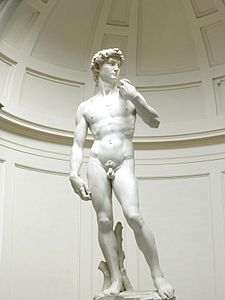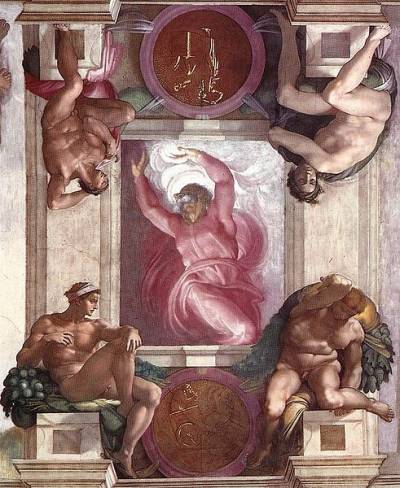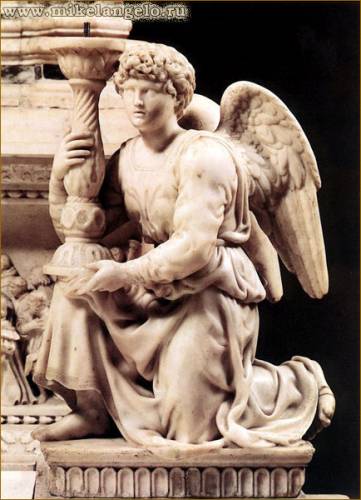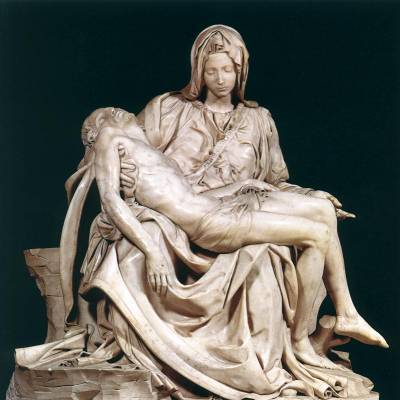|
Michelangelo
|
|
| Former-Teacher | Date: Wednesday, 14.03.2012, 13:40 | Message # 1 |
 Dean
Group: Admins
Messages: 504
Status: Offline
| Discuss the art of Michelangelo here.
|
| |
|
|
| Luck | Date: Wednesday, 21.03.2012, 22:42 | Message # 2 |
|
Union organizer
Group: Friends
Messages: 172
Status: Offline
| The dazzling achievements of the High Renaissance reached their highest point in the work of Michelangelo. Michelangelo joined an idea of beauty and force, a vision of a glorious but possible humanity which has never had its like in modern time. No other artist has employed the sense of movement and the power of rendering it as Michaelangelo did, on the one subject where its full value can be manifested - the nude. Many other artists had taken the nude for a subject before Michaelangelo. They were interested in rendering material significance but in the works of Michaelangelo the nude is primarily an expression of the spiritual force.
For the taste of today, there is much in Michaelangelo’s pictures that savours of artificiality, of an academic approach to bodily structure, yet at the same time we must admit that it is the perfect vehicle for the gloom, the bitter sadness he wanted to convey. All light, all grace, all warmth have been denied to to this race of punished giants.
One of the most famous works by Michelangelo is the “Creation of Adam”. Michaelangelo does not tell the story of man’s creation through details of the surrounding setting. He renders it through the figures themselves - their pose and certain deliberate distortions of form. It tells the story of spiritual birth. It makes us realize the power of God and transfers the sense of the fact that spiritual power influences everything and everyone. Adam is not depicted next to God but still he is tighted with Him physically and emotionally since he is His son.
|
| |
|
|
| Rina | Date: Thursday, 22.03.2012, 12:13 | Message # 3 |
 Union committee president
Group: Friends
Messages: 208
Status: Offline
| Michelangelo is regarded to be the greatest artist, sculptor, painter, architect, poet, and engineer of the Renaissance who managed to reflect all the beauty and perfection of human being in his works. Michelangelo managed to embody the main postulate of Renaissance that consists in shifting artistic focus from the spiritual to physical aspect. He was the first who revealed the perfection of human body, whose strength and beauty deserve admiration.
David is one of the most well-known sculptures in the world and one of the greatest masterpieces of the Renaissance. Michaelangelo violated the tradition of depicting David as a fragile adolescent with Goliath’s head. He created an image of a young man, full of inner strength, holding his sling in his hand, preparing for a battle. His face expresses fury and spiritual power which Michelangelo's contemporaries called “terribilita” that means “frighting, intimidating”. If one compares David fullface and in profile, one can notice the growing tension of his face – the range of emotions from tranquil concentration to ferocious and stern look.
 
|
| |
|
|
| Asya | Date: Thursday, 22.03.2012, 12:43 | Message # 4 |
 Union committee president
Group: Moders
Messages: 298
Status: Offline
| When people begin speaking about art, I prefer to keep silent. Mainly, because I'm not an expert in this field at all. But There are certain artists and sculptors I really like. And Michelangelo is one of them. I clearly remember having made two reports about him when studying at school.
He is one of the greatest artists of all time, a man whose name has become synonymous with the word "masterpiece": Michelangelo Buonarroti.
As an artist he was unmatched, the creator of works of sublime beauty that express the full breadth of the human condition. Yet in a world where art flourished only with patronage, Michelangelo was caught between the conflicting powers and whims of the Medici family in Florence, and the Papacy in Rome. Unlike many artists of his time, his genius was recognized, but at what cost to his personal life? If you are interested in Michaelangelo's biography, follow this link.
Michelangelo is famous for a number of his works, like "David" or "Creation of Adam". But I'd like to focus on the ceiling of the Sistine Chapel in the Vatican in general.
It's about 40 meters (131 feet) long by 13 meters (43 feet) wide. These numbers are rounded off just a tad, but don't detract from the fact that Michelangelo painted well over 5,000 square feet of frescoes.It took him a bit over four years, from July of 1508 to October of 1512. The main panels down the center depict scenes from the Book of Genesis, from the Creation, to the Fall, to shortly after Noah's deluge.
Adjacent to each of these scenes, on either side, are immense portraits of prophets and sibyls who foretold the coming of the Messiah. Along the bottoms of these run spandrels and lunettes containing the ancestors of Jesus and stories of tragedy in ancient Israel. Scattered throughout are smaller figures, cherubs and ignudi (nudes). By the way, have you noticed the wealth of architectural members and moldings which dissect the ceiling? Most of those are actually two-dimensional, skillfully painted in by Michelangelo to demarcate separate compositions.
|
| |
|
|
| Tanya | Date: Thursday, 22.03.2012, 13:09 | Message # 5 |
 Course monitor
Group: Friends
Messages: 61
Status: Offline
| Michelangelo is a great Italian painter, architect, poet, and engineer who exerted an unparalleled influence on the development of Western art. He had developed his own style of painting that would be called ‘Highly Impassioned’. We should say that his style of painting is characterized by impressiveness in depth and in artistic patterns. From little up his father wanted to educate him in grammar and language but most of all Michelangelo was interested in copying of the paintings done by masters. Than after a time he began to create his own great works. I would like to focus on the “Creation”. The three Creation pictures show scenes from the first chapter of Genesis, which relates that God created the Earth and all that is in it in six days, resting on the seventh day. All these three scenes are the most broadly conceived the most broadly painted and the most dynamic of all the pictures.

|
| |
|
|
| MissJane | Date: Tuesday, 27.03.2012, 23:39 | Message # 6 |
 Union organizer
Group: Friends
Messages: 193
Status: Offline
| For me Michelangelo is first a sculptor, and only then - a painter. I just can't resist the temptation to touch the sculpture, to feel the coldness of the marble, the smoothness of the surface and wonder at the sharpness of the master's eye and his dexterous hand. I can't single out the reasons but I don't have the same feeling when I look at his paintings. Maybe his sculptures just look more true to life as they are three-dimensional and worked out in detail.

Let's look at his splendid statue of an angel holding a decorative candlestick. The plaits of the attire convince you that it is not stone but fabric. The detailed representation of the feathers of the angel's wings creates the impression of softness and delicacy of the material. The curls on his head seem to be naturally coiled. But this all is stone! This is what makes me stand in awe in front of his works.
|
| |
|
|
| Ayayulia | Date: Wednesday, 28.03.2012, 10:32 | Message # 7 |
 Union organizer
Group: Friends
Messages: 126
Status: Offline
| I associate the name of Michelangelo Buonarroti mainly with his sculptures. The first 2 works occurred to me were “The Pietà” and “The Statue of David”. “David” is already described by Rina, so I’ll try to analyse “The Pietà”.
Italian painter Vasari said about the sculpture: "It is certainly a miracle that a formless block of stone could ever have been reduced to a perfection that nature is scarcely able to create in the flesh". I think that everyone shares his feelings. The sculpture depicts the body of Jesus on the lap of his Mother after the Crucifixion.

The figures are quite out of proportion and not only because it is difficult to depict a fully-grown man in a woman’s lap. We see that nevertheless they seem quite natural. The second interesting thing is that Mary is represented as being very young and there are different interpretations of such an appearance. Michelangelo said about the matter: “Do you not know that chaste women stay fresh much more than those who are not chaste? How much more in the case of the Virgin, who had never experienced the least lascivious desire that might change her body?” Another exposition says that the viewer is actually looking at an image of Mary holding the baby Jesus. Mary's youthful appearance and apparently serene facial expression, coupled with the position of the arms could suggest that she is seeing her child, while the viewer is seeing an image of the future. And the second description seems more interesting and deep. Looking at the works downloaded on this page I am captured with the feeling of inspiration. It is a real art that leaves traces for ever.

|
| |
|
|
| Teacher | Date: Wednesday, 28.03.2012, 13:41 | Message # 8 |
 Head teacher
Group: Admins
Messages: 375
Status: Offline
| Michelangelo di Lodovico Buonarroti Simoni (6 March 1475 – 18 February 1564), commonly known as Michelangelo was an Italian Renaissance sculptor, painter, architect, poet, and engineer who exerted an unparalleled influence on the development of Western art.
Michelangelo can also be regarded as a very challenging artist. His masterpieces caused a plethora of arguments.
The Last Judgment is a canonical fresco executed on the altar wall of the Sistine Chapel in Vatican City. The work took four years to complete and was done between 1536 and 1541.
The work is magnificent and spans the entire wall behind the altar of the Sistine Chapel. It is a depiction of the Second Coming of Christ and the final and eternal judgment by God of all humanity. The souls of humans rise and descend to their fates, as judged by Christ surrounded by prominent saints including Saints Catherine of Alexandria, Peter, Lawrence, Bartholomew, Paul, Peter Simon, Sebastian, John the Baptist, and others.
The Last Judgment was an object of a heavy dispute between critics within the Catholic Reformation and those who understood the genius of the artist and the mannerist style of the painting. Michelangelo was accused of being insensitive to proper decorum, and of flaunting personal style over appropriate depictions of content.

Michelangelo. The Last Judgement (1537-1541, Sistine Chapel, Vatican City)
In Vino Veritas...
|
| |
|
|
| Nastay62rus | Date: Tuesday, 08.01.2013, 09:37 | Message # 9 |
|
Union organizer
Group: Users
Messages: 102
Status: Offline
| Genius Michelangelo affected not only Renaissance art, but also all further world culture. Its activity is connected generally with two Italian cities — Florence and Rome
|
| |
|
|
| Perilova | Date: Sunday, 14.04.2013, 21:48 | Message # 10 |
|
Head teacher
Group: Reliable
Messages: 320
Status: Offline
| Quote (Nastay62rus) Genius Michelangelo affected not only Renaissance art, but also all further world culture. Its activity is connected generally with two Italian cities — Florence and Rome
What his creatures are the most popular ? What do you know about his life ? Do you believe he is a talanted person ?
|
| |
|
|
|












